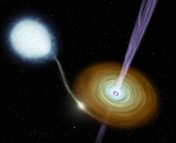Title: A massive white-dwarf merger product prior to collapse
Authors: Vasilii V. Gvaramadze, Götz Gräfener, Norbert Langer, Olga V. Maryeva, Alexei Y. Kniazev, Alexander S. Moskvitin and Olga I. Spiridonova
First Author’s Institution: Sternberg Astronomical Institute, Lomonosov Moscow State University, Moscow, Russia
Status: Open access on arXiv
You may have read about the ongoing debate over the progenitors of Type 1a supernovae. One of the proposed scenarios for producing a Type 1a supernova is the merger of two white dwarfs. When the total mass of the merging white dwarfs exceeds the Chandrasekhar limit, the merger product can go up in flames in a thermonuclear explosion that gives rise to a Type 1a supernova. But what happens if the merger product avoids this fate? Today’s paper reports the discovery of an object that may have done just that!
A merger product that avoids going supernova is expected to form a nebula, with a hot, highly magnetized, fast-rotating central star. The nebula would be hydrogen- and helium-free, which makes sense given that white dwarfs are typically composed of carbon and oxygen. The star could proceed to survive for tens of thousands of years before its ultimate collapse, likely leaving behind a neutron star!
The authors of today’s paper were looking for circumstellar nebulae when they found a new one in the constellation Cassiopeia. They were even able to identify the central star of the nebula. Fig 1 shows the nebula as well as the star, both of which we will refer to by the same name: WS35.

Figure 1. The upper two panels show the WISE (Wide-field Infrared Survey Explorer) infrared images of the nebula WS35 at different intensities, highlighting its structural features. The nebula appears as a circular shell with ragged edges (top right) but the higher contrast image (top left) also reveals a diffuse halo around the shell. The bottom left panel is also a WISE image at a different wavelength while the bottom right image is from IPHAS (INT Photometric Hα Survey) and shows no optical counterpart for the nebula. The circles indicate the position of the central star. Figure 1 in the paper.
Follow up spectroscopy of WS35 was done using the Russian 6 meter telescope and revealed a spectrum dominated by emission lines from the central star (see Fig 2). Once you have the spectrum of a star, you can try to fit it in order to deduce some of its properties. Stellar atmosphere models are used to predict the observed spectrum based on parameters such as the temperature and composition of the star. The authors used a (tailored) stellar atmosphere model and found that they could reproduce the observed spectrum quite well. The surface temperature of the star was determined to be about 200,000 K. Its chemical composition appears to be dominated by oxygen and carbon, without any hydrogen or helium. Stars that are both hot and free of hydrogen and helium are rare. In fact, very few such stars are known in the Milky Way!
While the spectrum looks like that of oxygen-rich Wolf Rayet stars, the lines we see here are much stronger and broader. The authors inferred an unusually high stellar wind velocity of ~16,000 km/s. Such high velocities are not seen for normal, radiation-driven winds. They can, however, be explained by invoking rapid rotation and strong magnetic fields that aid the wind acceleration. This aligns nicely with the white dwarf merger scenario since stellar mergers are expected to generate strong magnetic fields.

Figure 2. Observed optical spectrum (black line) of WS35. The x-axis gives the wavelength of the radiation and the y-axis gives the corresponding flux. The best fit model (red line) is also shown. The lower red line shows the continuum flux for the model. Figure 2 in the paper.
The merger scenario is further supported by the fact that models of super-Chandrasekhar mass merger remnants can match the properties of WS35 very well. Not only do the models fit the Hertzsprung-Russell diagram location of WS35, they also predict extreme mass loss during and after merger, with the eventual formation of a hydrogen- and helium-free circumstellar nebula. Fig 3 shows the position of the star on the HR diagram, well-reproduced by a recent model of the post-merger evolution of such remnants. The star’s luminosity was inferred based on its Gaia distance. The temperature of W35 is very high and it appears to be almost at the endpoint of its post-merger evolution.

Figure 3. WS35 (red cross) on the Hertzsprung-Russell diagram. The black line represents the evolutionary track of a carbon-oxygen white dwarf post-merger model from Schwab et al. (2016). The colored dots (1-4) indicate various important stages as the remnant evolves and burns. The time elapsed between the stages is also given. Point 1 is reached in only ~100 years, evolution from point 1 to point 4 takes up to ~20 kyr, and the track ends at ~25 kyr. Figure 3 in the paper. For the curious, also see Figure 11 in Schwab et al. 2016.
So, what happens next? WS35 will eventually collapse and the authors believe that it is likely to produce a neutrino-flash and a gamma-ray burst, followed by a very fast and subluminous Type Ic supernova. For now though, the existence of this object tells us that it’s certainly possible for a super-Chandrasekhar mass merger to avoid thermonuclear explosion.




